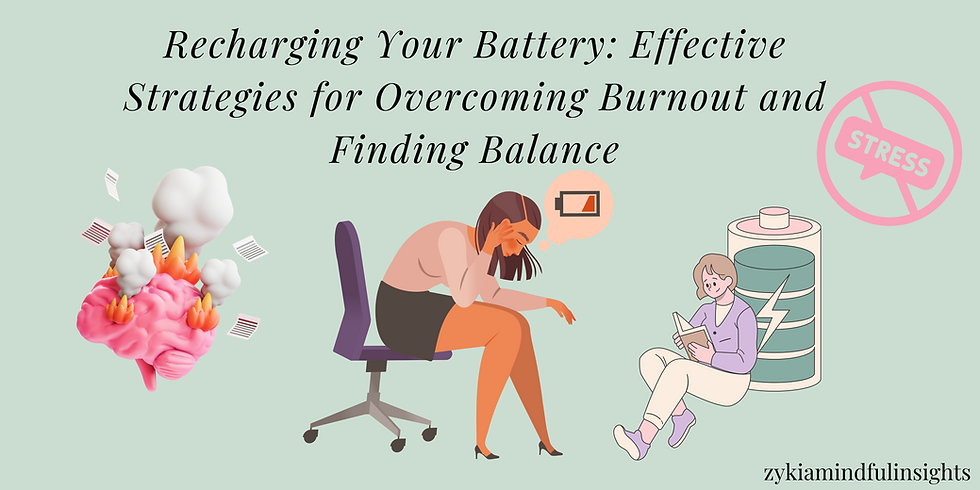How to Establish Healthy Boundaries in Your Relationship for a Stronger Connection
- Zykia Hannah

- Mar 10, 2024
- 8 min read
What are healthy boundaries?
Boundaries are often likened to walls, seemingly separating individuals, yet they are far from negative constructs. Instead, they serve as vital components in fostering healthy and equitable relationships. These limits safeguard your sense of self, mental equilibrium, and overall health.
They encompass a spectrum of constraints, ranging from practical requests like refraining from browsing through your phone to more profound emotional needs such as acknowledging differences in aspirations within a partnership.

Establishing healthy boundaries accomplishes several key objectives:
Fosters independence and diminishes codependent tendencies.
Establishes clear guidelines for interactions with others.
Instills a feeling of empowerment and self-esteem.
Safeguards both physical and emotional well-being.
Defines individual roles and obligations within relationships.
Distinguishes personal desires, needs, thoughts, and emotions from those of others.
In the absence of healthy boundaries, relationships can devolve into toxicity, leaving you dissatisfied and compromising your well-being. For instance, constantly lending money to a friend or assuming responsibility for solving all of your partner’s emotional struggles can leave you feeling exploited and overwhelmed. Similarly, if a parent consistently intrudes on your privacy, resentment is likely to build.
This dynamic isn’t confined to personal relationships alone; it extends to the workplace, where colleagues or superiors may overstep boundaries, monopolizing your time or neglecting your needs. Such unhealthy boundaries can spill over into your personal life, diminishing its quality.
Research suggests that blurred lines between work and personal life contribute to emotional exhaustion and decreased happiness. Conversely, establishing clear boundaries, particularly regarding job responsibilities, fosters a sense of empowerment.
Mastering the art of boundary-setting can significantly transform various aspects of your life, from professional to familial and romantic relationships. It begins with recognizing the distinction between healthy and unhealthy boundaries.
Self-Reflection and Awareness:
Before establishing boundaries in your relationship, it’s essential to engage in self-reflection and become aware of your own needs, values, and limits. Take the time to understand what makes you feel comfortable and respected, as well as what behaviors or actions cross your boundaries. This introspection allows you to articulate your boundaries effectively and communicate them to your partner with clarity.
Open Communication:
Effective communication is the cornerstone of setting healthy boundaries in a relationship. Create a safe and open environment where both you and your partner can express your thoughts, feelings, and concerns without fear of judgment. Use “I” statements to convey your needs and boundaries, focusing on how certain behaviors impact you personally. Encourage your partner to share their perspective as well, fostering mutual understanding and respect.
Establish Clear Boundaries:
Once you’ve identified your boundaries and communicated them with your partner, it’s crucial to establish clear and specific boundaries. Be explicit about what behaviors are acceptable and unacceptable in the relationship. Whether it’s regarding personal space, communication habits, or emotional support, clearly define the boundaries to avoid confusion or misinterpretation.
Consistency and Respect:
Consistency is key in maintaining healthy boundaries within a relationship. Once boundaries are set, it’s important to uphold them consistently. This demonstrates respect for yourself and your partner, reinforcing the importance of mutual understanding and adherence to agreed-upon boundaries. Similarly, respect your partner’s boundaries, acknowledging their needs and limitations with empathy and consideration.
Reassessment and Adaptation:
As relationships evolve and circumstances change, it’s essential to periodically reassess and adapt your boundaries accordingly. Check in with yourself and your partner regularly to ensure that your boundaries continue to align with your needs and values. Be open to renegotiating boundaries as necessary, accommodating growth and addressing any new challenges or dynamics that may arise in the relationship. Flexibility and willingness to adapt contribute to the ongoing health and resilience of your partnership.

Types of Healthy Boundaries
Personal boundaries manifest in various forms, and not every relationship necessitates addressing each type of boundary. For instance, while you may need to establish physical boundaries with a coworker, financial boundaries might not be relevant.
Physical boundaries serve to maintain your comfort and safety, not only in interactions with strangers but also in relationships with loved ones. For instance, expressing a preference for handshakes over hugs or communicating the need for a break during a strenuous bike ride illustrates setting physical boundaries. Similarly, asserting ownership over a physical space, such as your bedroom or office, allows you to define limitations on intrusion or clutter.
Sexual boundaries encompass a range of behaviors, from seeking consent before intimacy to periodically checking in with your partner's comfort level during sexual activity. Even in long-term relationships, ongoing communication about preferences and expectations regarding sexual intimacy is vital. Revisiting boundaries concerning aspects like the frequency of sexual activity or contraception use ensures mutual respect and understanding.
Emotional boundaries safeguard your emotional well-being and internal equilibrium by ensuring that others respect your feelings and comfort level. Communicating boundaries such as "I prefer not to discuss this topic at work as I need to concentrate" establishes emotional boundaries. Additionally, these boundaries protect you from feeling overwhelmed by others' emotions, affirming that you're not accountable for their reactions to your decisions.
Material and financial boundaries pertain to your possessions, including money, clothing, vehicles, or living space. While generosity is admirable, it's essential to set limits to prevent exploitation of goodwill. Communicating boundaries such as "You can borrow my phone charger, but please return it afterward" or "I'm unable to lend you money for new shoes" establishes clear expectations regarding material possessions and financial assistance.
Time boundaries provide the framework for prioritizing your commitments at work and in your personal life while safeguarding against feeling overwhelmed by the demands of others. Picture a scenario where you've endured a taxing workweek and seek to dedicate the weekend to rejuvenation. Declining a party invitation or stipulating a specific duration for attendance illustrates setting time boundaries. Additionally, time-related limitations might involve requesting that a friend refrain from contacting you during designated work hours or postponing a significant discussion with a partner until a more suitable moment arises.
Unhealthy Boundaries
Unhealthy boundaries often manifest in extremes: either excessively rigid or overly porous. Healthy boundaries strike a balance between these two ends of the spectrum.
Rigid boundaries create distance between oneself and others, even those close to you. This might entail reluctance to discuss emotions with a partner or infrequent social engagements with friends.
Porous or weak boundaries emerge when saying "no" becomes challenging, leading to an excessive willingness to shoulder all responsibilities in a relationship or an inclination to overshare with acquaintances.
Various factors contribute to the struggle with unhealthy boundaries:
- Desire for control: Some individuals manipulate boundaries to exert control over others, using rigid boundaries to stonewall conversations until their demands are met.
- Fear of rejection: Fear that revealing flaws will result in abandonment may hinder emotional openness in relationships.
- Lack of boundary-setting experience: Growing up in an environment with poor boundary management can make establishing healthy limits challenging, as behaviors normalized in childhood may persist into adulthood.
- Overly agreeable personality: A strong desire to please others can lead to discomfort-ignoring behaviors, such as overcommitting or agreeing to tasks out of a need for acceptance.
- Low self-esteem: Feelings of unworthiness or identity deficiency may prioritize others' needs over personal comfort, leading to unrecognized discomfort and unmet needs.
How to Set and Maintain Boundaries
Commencing the establishment of boundaries early in a relationship typically yields optimal results, yet reinforcing healthy guidelines and limitations can bolster any stage of a relationship.
Often, the necessity for a particular boundary may only become apparent as you deepen your understanding of each other. For instance, it may take time to recognize persistent distractions from a coworker during work hours or to identify signs of excessive control from a romantic partner.
The ensuing guidance aims to assist you in setting boundaries should you encounter challenges in communicating or establishing rapport with someone in your life.
Setting boundaries : Know what you want in a relationship
In both romantic and platonic relationships, articulating your needs is challenging when they're not clearly defined. Initiating this process often begins with introspection into your values and beliefs.
Pose questions such as:
- What attributes do I appreciate in relationships?
- Which behaviors do I find irksome?
- What qualities do I admire in others?
- Which material possessions hold significance for me, and why?
- How do I prefer to allocate my time?
- What activities bring me a sense of fulfillment?
By delving deeper into self-awareness, you can envisage the boundaries necessary for your well-being. For instance, valuing independence may lead to setting financial guidelines in a partnership, while prioritizing productivity or privacy may entail establishing physical boundaries with coworkers who intrude on your workspace.
Assessing how you feel with someone
Reflecting on your emotional responses after interacting with others can be instrumental in identifying necessary boundaries. Consider asking yourself the following questions:
Did the other person's jokes or comments leave you feeling disrespected?
Did their actions provoke any physical discomfort or feelings of insecurity, such as raising their voice in anger?
Were you coerced into activities that contradicted your values?
Did you feel overwhelmed by their demands or expectations of you?
Did you sense a loss of autonomy or feel patronized by their behavior?
Taking a moment to ponder these inquiries can aid in determining whether setting boundaries with the individual is warranted in future interactions.
How to respond when someone else sets a boundary
Setting boundaries is not a one-sided endeavor; it involves both parties. When someone communicates a boundary, you might experience feelings of shame or frustration, perceiving it as a form of rebuke or a challenge to your autonomy.
As you encounter these emotions, there may be a tendency to immediately defend your actions, prompting negative reactions. However, it's crucial to recognize that honoring boundaries contributes to the other person's sense of safety and contentment, enriching the relationship.
In such moments, it's beneficial to pause, take a deep breath, and listen attentively. Engaging in deep, slow breathing can mitigate the activation of your nervous system's "fight or flight" response, facilitating receptiveness to the communicated boundary rather than readiness for confrontation.
Acknowledge that the individual setting the boundary is the best judge of their own needs and well-being. If a certain boundary doesn't align with your preferences, express your concerns openly to facilitate mutual compromise.
Recognize that each person has their unique way of processing and experiencing emotions. Avoid making assumptions about your partner's needs without them articulating them explicitly. Provide them with the space to express their desires and preferences freely.
Offer apologies when appropriate, acknowledging that everyone is fallible and prone to making mistakes. Whether it's inadvertently crossing a boundary by making an insensitive remark or sharing too much information, demonstrate humility by apologizing sincerely. If needed, seek clarification to ensure a thorough understanding of the boundary in question.
By embracing and respecting the boundaries of others, you pave the way for stronger connections with those around you. Effective boundary-setting fosters a sense of empowerment for both parties and cultivates healthier, more fulfilling relationships.
In navigating the intricacies of relationships, setting and respecting boundaries emerges as a cornerstone of fostering mutual understanding, respect, and fulfillment. From understanding one's own needs and limits to communicating effectively, from embracing the boundaries set by others to maintaining humility and accountability, each step contributes to the cultivation of healthier connections. By fostering a culture of empathy, open communication, and mutual respect, we pave the way for relationships that empower, enrich, and endure, ultimately leading to greater satisfaction and fulfillment for all involved.
🩷Quote of the day:
"Try to be a rainbow in someone else's cloud." - Maya Angelou




Comments